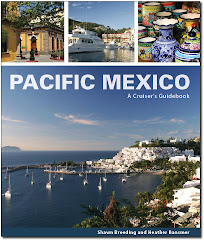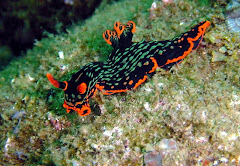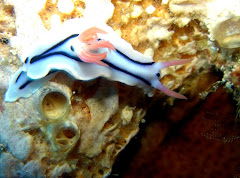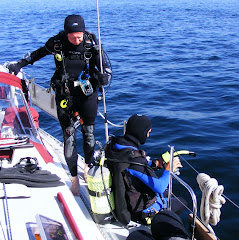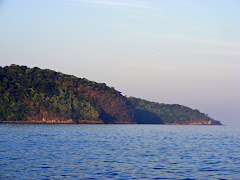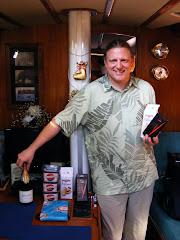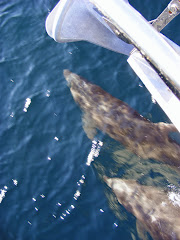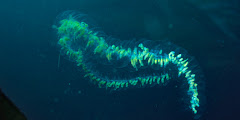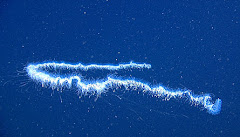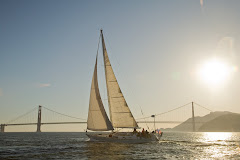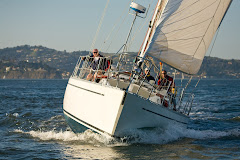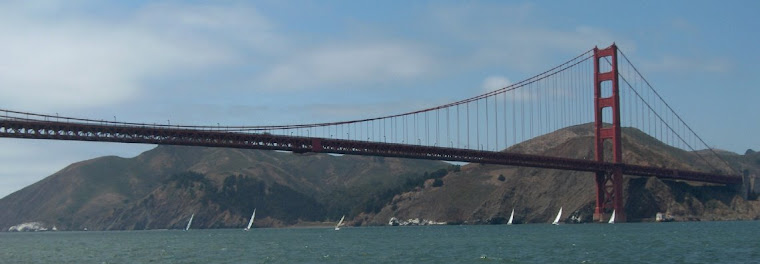I've had a couple of questions from friends and family about what we experienced onboard Music when the tsunami came through, so I thought I'd share a little bit with you.
To start with, when we heard about the approaching tsunami I set our VHF radio to “scan” because on our normal cruiser communication channel (channel 22) I was hearing what appeared to be some audio distortion to someone’s communication. Since I wanted to be sure our radio was not suddenly malfunctioning. I put it in “scan” mode to see what we could pick up. Then, while in “scan” mode I picked up someone else’s conversation and they were discussing a projected “tsunami”. Well, I wasn’t quite sure if it was real or rumor, so I pressed the microphone button and said “break”. When acknowledged, I asked my question, and was subsequently given details. With that, I switched back to channel 22, and announced to the fleet in the cove of Las Hadas if anyone knew of a potential tsunami? That seemed to wake up the cruising community and started a lot of discussion. (Mexico’s president had issued a tsunami warning that morning, which was lifted about 9PM local time.)
The net result was that most of us decided that we should head to deeper water and monitor the situation. Within 15 minutes Gail and I had our anchor up and were heading out of the cove into deeper water. Once out with about 200 ft of depth under Music I tuned our SSB radio to get more information. Basically we learned that while the first event (that’s what they called it) was to occur about 1:30PM local time, there was a 6 to 7 hour window for subsequent events. Well, that meant that we would be out on the water the rest of the morning and all afternoon. And heck, it was a gorgeous day, so we decided that instead of just floating there we’d start our retreat to Banderas Bay, and head about 30 miles north to Bahia Tenacatita.
En route we heard about the port captain closing Barra de Navidad due to strong currents in the bottle neck channel going into the lagoon. A first hand report mentioned that the buoys were getting drug under water. – Well, the buoys in Barra are rather undersize compared with most “normal” channel buoys so that’s not hard to imagine. The next day we found out that in addition to the buoys being drug under water the more significant event issue was that the water pipe (maybe more like a hose?) running across the channel, and anchored to its bottom, floated free. This subsequently resulted in the “port” being closed for several days, not just over night as I originally thought.
In Banderas Bay the ports captains (there are 3 major ports as far as I know) closed their respective ports over night so many of those out on the bay, floated, bobbed, or sailed all night as many of the boats were participating in Banderas Bay race week and didn’t have any anchors onboard. The cruisers who left port, got to sleep that night after anchoring.
What the tsunami did in port areas such as Nuevo Vallarta and even la Cruz was surge in and out, and in and out. La Cruz suffered some relatively minor dock damage but that was it. It appears that some of the smaller bays such as Tenacatita where we anchored that night, essentially filled up a bit more than usual and the water in them sloshed around for a day or so.
While this was our event, our hearts go out to all of the earthquake victims and to all of those less fortunate along the various coasts that the tsunami did reach in force. - John
Sunday, March 27, 2011
Fat Tuesday in Barra
Jim and Diana caught a taxi to the airport from Barra de Navidad on Tuesday morning, a week before the Catholic holiday of “Fat Tuesday”. After seeing them off, Gail and I stayed in town, having a leisurely lunch on the upper deck of a restaurant overlooking Bahia de Navidad (see photo labeled “Bahia de Navidad” from our post of “New Times, Old Friends, New Friends… ”). Mid afternoon, we were ambling down the street when we ran into friends from s/v Serendipity. Hugh and Ann asked if we were interested in staying for the “Fat Tuesday” parade (here in Barra the parade was actually 1 week before Fat Tuesday) so we replied, “Why not”!
 |
| Some floats, like this one, were really quite colorful and very well done. |
It was a real treat to see how the locals celebrated the holiday with a street carnival during the day and a parade in the early evening. The parade itself was really quite casual with no police motor cycles or crowd control. Locals of all ages from kids to adults participated in the parade, with most in costume. Some of the parade entries were quite simple, consisting of someone’s car or truck with a bunch of kids or teens sitting on the hood or standing in the back, while others were actual floats pulled by farm tractors or trucks, see photo in the side bar.
As the parade progressed, someone on a float was tossing candy to the kids lining the route, and I happened to look into the face of one of the kids disappointed at missing out. With that, I hoped across the street, passing between floats, and ducked into a tienda, neighborhood convenience store, where I bought a bunch of candy. To the delight of both moms and kids, I handed out candy to as many kids as I could while walking along the parade route in our area. – What fun! Public festivities concluded with men dressed as vaqueros, or cowboys closing the parade. Hugh and Ann headed to a bar or restaurant for dinner while Gail and I took our dinghy back to Music. While sad to see Jim and Diana leave, the evening was a sign of more adventures to come.
Saturday, March 26, 2011
A Note on Jim and Diana's Visit
 |
Jim Jessie driving Music enroute from Ensenada Carrizal to Bhia Tenacatita |
While it was fun having Jim and Diana on board, what we really benefitted from were all of the small hints they imparted to us. For example, we’d had a water maker on board since 2008, and we really benefitted from it during our Pacific Cup race. While on that race we really appreciated the showers the fresh water afforded us. What we didn’t appreciate was all the additional showers we could have had if we’d have saved the water we dumped overboard! Here’s how it works: When the water maker cycles into making water the saline content decreases to “potable” levels but there is still a time when it just doesn’t taste or smell fresh. And between the “saline potable” and “fresh taste” a whole lot of water goes down the drain that can be used for such things as rinsing dive gear, rinsing cloths, or maybe even taking showers! How about that? As it turned out we were perfectly set up to gain some real benefit from all the “in between water” we were letting go down the drain. We just hadn’t done so. Now, due to Jim’s suggestion, we collect that “in between” water in our shower bag, let the sun heat it up and viola, we have an extra 2 to 5 gallons for additional use every time we make water.
Another tidbit from Jim was that while we have a light line securing our anchor to the base of the forestay to keep it from inadvertently deploying, it would be better to install a small shackle on the stem fitting and feed the securing line through it to avoid any potential chafe issues. It seems that somewhere in their travels they had a light line rigged securing their anchor similar to ours and it had chaffed through. With that, in my mind’s eye, I could just see Music crossing the Sea of Cortez, slamming off of a 4 foot wave, the line chafing through, and the 55 pound anchor along with 200 feet of chain deploying in deep, deep water. That could be ugly, so now we have just such as shackle installed and anchor securing line re-lead.
Then, there was the time Diana pointed out to me that once on Nalu 4 they had a carving knife jump off the counter and over the 2 inch rail, just like we’ve got. It stabbed the floor right next to a crew’s foot, due to unexpected wave. Now we pay attention to where we set sharp implements, particularly while at sea or in “rolly” anchorages.
One day Diana asked if we knew how to make ice cream onboard. Her recipe was simple, but I am only allowed to reveal it upon pain of death. But basically you use a hand egg beater (like your mom used to use) to mix cream, canned sweetened condensed milk, vanilla, and in our case berries, together. Then you put the concoction into the freezer (called the evaporator box on board a sail boat) and let it set up. The key is to have an evaporator box that gets cold enough! We’d learned previously that you might well be able to freeze ice in your evaporator box, and maybe even meet, but it’s quite another thing to keep commercially made ice cream frozen, let alone freeze ice cream.
That said, my first project was to decrease the temperature in our evaporator box. We accomplished this by gluing 2 pieces of insulation together and then fitting them to make a lid for the evaporator box itself. This dropped the internal temperature from about 20 to 9 degrees Fahrenheit. Next, the ladies set out to acquire the necessary ingredients which turned out to be surprisingly easy. Then came the mixing, which required a strong arm or two. Once in the freezer, 12 hours later (don’t laugh) we had ice cream. – Seriously!
Unfortunately Jim and Diana left for home before our ice cream was firmly set up. Even so, the evening we made it, the four of us enjoyed freshly baked pie (from our French baker of course) ala mode, with slightly soft homemade ice cream. Four days later, however, the real beneficiaries of our endeavors were our friends on s/v Full and By whom, following a steak dinner, we surprised with homemade ice cream while at anchor in Santiago Bay. Ahh – to be so clever. Truly the bar has been set, and at a very high level!
Thank you Jim and Diana!!
Monday, March 14, 2011
New Times, Old Friends, New Friends, and Mexico’s Gold Coast
We are presently in Bahia Chamela waiting with about 15 other boats for favorable conditions to round Cabo Corrientes heading back into Banderas Bay and La Cruz. We’ve been cruising Mexico’s Gold Coast now for about a month. The entire time, minus 2 days in Barra de Navidad, spent “on the hook” as they say. Rounding Cabo (cape) Corrientes will signal an end to this part of our cruise. We’ll be traveling in the states for most of April and in early May Music will head back up into the sea of Cortez for the summer there is still so much to see. But all of that’s in the future.
Just why is this section of coastline referred to as Mexico’s “Gold Coast”? Perhaps the historical answer is most easily found in the newest cruising guide Pacific Mexico, A Cruisers Guidebook; Shawn Breading and Heather Bansmer ©2010; pg 163: On the evening July 27, 1862, the engine room of SS Golden Gate caught fire and foundered about 12 miles south of Barra de Navidad. That night, many lives were lost along with 1.4 million dollars in gold. According to Shawn and Heather after significant storms, (or tsunami?) gold and silver coins can still be found washing up on the beach near the present day Manzanillo airport. Hmmm? Did we make a mistake in bypassing that beach after leaving Las Hadas in Manzanillo Bay? But, we’re getting ahead of ourselves. For us on Music, we have our own host of reasons for calling this cruising ground Mexico’s Gold Coast”. And gold isn’t one of them. - John
We left La Cruz roughly a month ago to head south to Bahia de Navidad to meet our friends, Jim and Diana Jessie, who would be cruising with us for a couple of weeks. Jim and Diana have sailed this area extensively over their many years of cruising, and Jim’s many years of racing prior to that, so it was great to have them as our tour guides. We visited a few of their favorite anchorages, did some snorkeling, practiced our dingy beach landings to visit some of the restaurant palapas on the beaches, and spent a lot of time catching up and listening to just some of their cruising stories over cocktails on board.
 |
| Bahia de Navidad from an upstairs outdoor restaurant where Gail and I had lunch. |
We spent the first couple of days at the marina in Barra de Navidad provisioning and loading up with baked goods from the French Baker. What a treat! An honest to goodness French Baker comes around to the marina and anchorage in the lagoon in his boat selling fresh baked baguettes, croissants, Danish, quiche, tarts, and more. After stalking up we then headed to Santiago Bay for a few days.
I think Santiago Bay is one of my favorite places. The water was relatively clear, the beach was long and beautiful, and it was a peaceful place to spend a few days. John and Jim did some snorkeling around the shallow wreck of a 300 ft. steel cargo ship driven aground in about 25 ft of water during a hurricane in 1959.
Las Hadas Resort and Anchorage, Manzanillo Bay
Then it was on to Las Hadas, a beautiful cove of an anchorage in an exquisite setting. Many years ago someone built a grand resort in a Moorish style of architecture and most other later developments have kept with the same theme. It’s almost fairy like. For a small dingy fee we could use the resort pool and facilities. Jim and Diana took us into Manzanillo to a favorite spot of theirs for dinner – the Colonial Hotel.
Las Hadas is a very special place for Jim and Diana, as it was from here that they took off for the South Pacific on their circumnavigation. And, it was here that they closed the loop, crossing their outbound track while heading back home to San Francisco Bay. We are both proud and privileged to have shared Las Hadas and Manzanillo with Jim and Diana, and to consider ourselves part of their extended family of cruising kids.
After a few days in Las Hadas we headed back to Bahia Santiago for a couple more days and John did a scuba dive on the wreck. Visibility wasn’t too good that day, but he seems to always find lots to look at even when others report a lousy dive. Our next anchorage was Ensenada Carrizal, an absolutely stunning cove, both beautiful and remote. Jim, John, and I snorkeled the north side of the cove our first day and the south side on our second. We concluded that the south side of the cove was the best with a gorgeous variegated carpet of red and brown corals, and even an octopus.
Carrizal is one of the few anchorages that has yet to be developed and Jim and Diana knew of the cove prior to its having been named in any cruising guide so they gave it their own name in honor of a good friend’s wife. With tradition firmly established, we gave Ensenada Carrizal our own place name, Jessie Bay, in honor of Jim and Diana Jessie.
The second morning anchored there while John and I were having our coffee up in the V-berth, we heard the unmistakable sound of a whale blow. We popped our heads out of the forward hatch and watched a momma and baby humpback whale working their way through the cove feeding along the tide line.
Next stop was Tenacatita where we went ashore for a nice meal at the local beach palapa. A specialty there is a local dish call Rollo de Mar – a fish fillet wrapped around shrimp and topped with a cream sauce. YUMMM! Unfortunately our time was running short with the Jessies, so it was back to Barra to bid them a fond farewell. We left Tenacatita early in the morning in hopes of getting back to Barra in time for the French Baker who started making his rounds at 8:30. We made it and had quiche for breakfast. Diana and I took an afternoon shopping trip into the town of Barra while John and Jim stayed on anchor watch in the lagoon that windy afternoon. The wind had picked up right after we came in and I’m glad we were well anchored by then.
After Jim and Diana left, we took the dingy in to Barra, as cruisers call it, had a mid afternoon meal on a terrace overlooking Bahia de Navidad, ran into some other cruising friends from s/v Serendipity, and enjoyed the local “Fat Tuesday” parade a week early. Two days later with clean laundry, a few fresh provisions, and full water tanks we headed back to Santiago Bay to meet up with Dick and Ann on Full and By, friends we’d made the acquaintance of months earlier at Santa Catalina Island while we were coming down the coast. It was great spending time with them and meeting some of their other cruising friends. But alas, the time came to move on since we needed to do some provisioning before starting the trek back north to La Cruz. Where to provision was simple. Due to its proximity to grocery stores our destination was once again Las Hadas. Our intention was to spend a few days poolside and toast a wonderful month as well as restock provisions.
Contrasts – What a difference a day Makes
Our last day in Santiago Bay started out magically. While we were having our morning coffee we heard something soft and distant, something that sounded like something rubbing. Having our morning coffee in the V-berth we were listening and feeling the pitch and fall of Music in the low swells. Then the rhythm changed ever so slightly but distinctly, and, we realized we were hearing our first whale songs in person.
 |
| Note the difference in size beween mom and her calf. |
Unfortunately it was time to go so we raised anchor and made for Las Hadas where we spent a relaxing afternoon by the pool and planned what we would do tomorrow – which included doing the provisioning.
A day later we awoke to a tsunami warning due to the massive earthquake in Japan. Fortunately, waves shouldn’t strike the Mexican coast for a few hours. Even so, we decided the prudent thing would be to head for deeper water and wait for things to settle down. Within 20 minutes the anchor was on deck and we were motoring out.
Once out in 300 feet of water since it was a beautiful day, and since we’d be out here for a several hours (reports were for possible successive events to occur within a 6 hour window after the first waves struck) we decided we might as well start heading north. So, off we headed for Tenacatita. We had been talking on the radio with some other boats in Las Hadas so we “buddy boated” with them. While heading into Tenacatita, a whale surfaced less than 25 yards off our port bow.
While approaching Tenacatita and preparing to drop the hook there was a lot of chatter on the radio with folks cautioning us to wait a bit before anchoring. It seems they were still having “events” in the bay and the boats at anchor were swinging around crazily while experiencing about a 5 to 10 ft change in water level over a 30 minute period associated with a lot of current.
Normally, boats all face in the pretty much the same direction in an anchorage – either into the current or the wind – except perhaps at tide change. But these boats were facing in all different directions and swinging around like crazy! Taking our time we waited until things settled down before anchoring in about 40 feet of water where we put out 200 ft of chain and had a pretty uneventful night.
In the morning, with a gentle breeze off the port beam, we headed to Chamela, which is both a new anchorage for us having bypassed it on our way south, and our last before rounding Cabo Corrientes heading back into Banderas Bay. We’ll be here a few days waiting for favorable conditions for our northward rounding of Cabo Corrientes, and while we have to say good bye to the Gold Coast, we’ve also want to acknowledge we’ve had a ball. – Gail & John;
(Note: While the introduction, editing and additions are from John, the general text was written by Gail. Additions by John were inserted from Gail's perspective for consistency.)
Subscribe to:
Posts (Atom)




